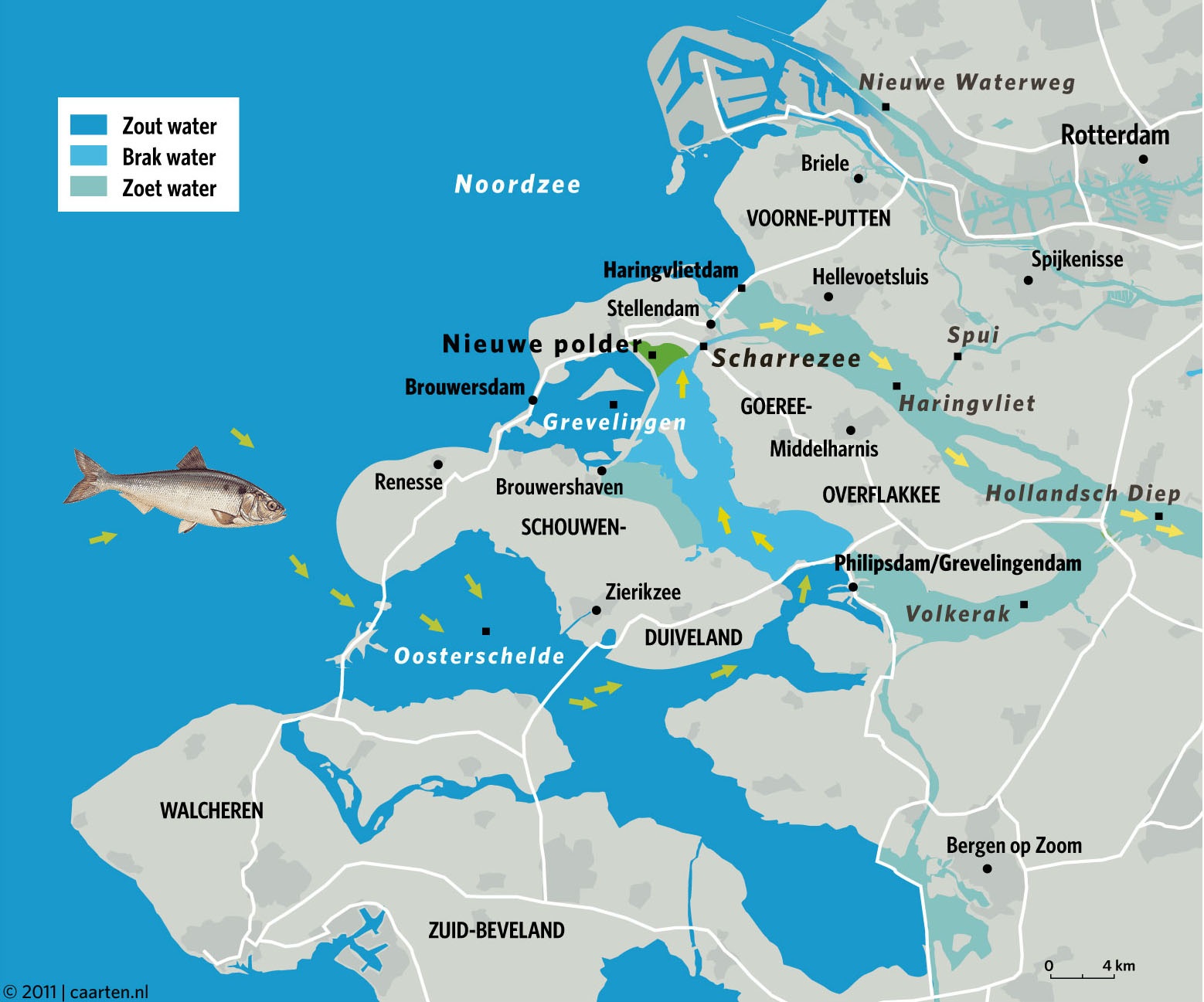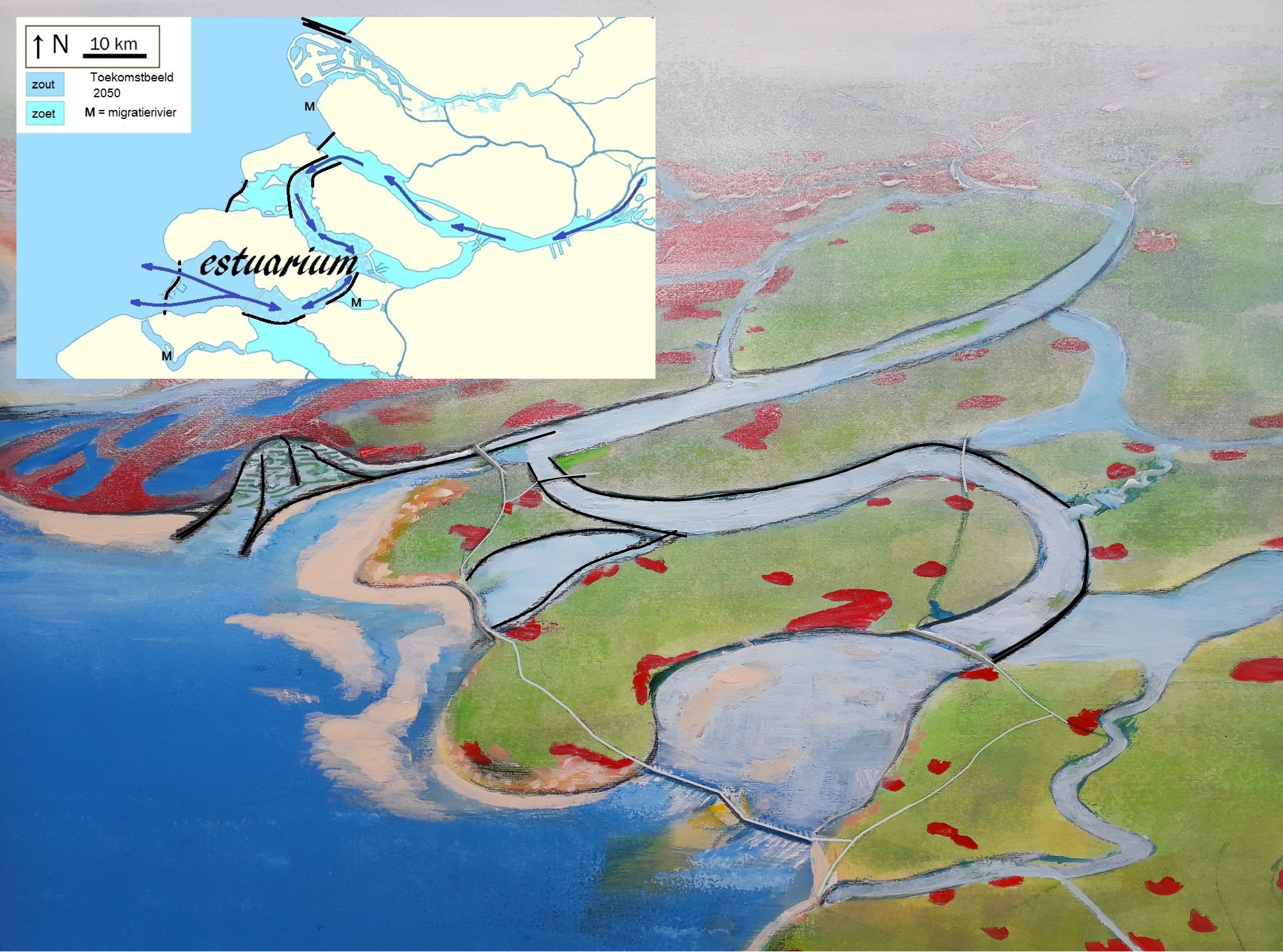Open de poort voor de trekvis
Adviesgroep Borm & Huijgens – integraal waterbeheer
januari 2013
Fish that migrates to, as well as from the sea,
need a period of a few weeks to adapt physical to the change from fresh
water to salt water and the other way round.
In order to achieve this, it is necessary to have an open connection
with the sea, whereby, under the influence of tides en currents, salt
and fresh water can mix over a considerable distance.
With the choice of the Haringvliet as a complete river mouth, the salt
water will reach an unacceptable long distance land inwards, which is
certainly not wanted.
Under all other circumstances, the Haringvliet sluices are a bottleneck
for fish migration. Therefore, a narrow opening of the sluices will
definitely not work.
But with a lengthened flow-route between the Haringvliet and the sea,
large scale return of migratory fish, together with the repelling of
the salt water border, will certainly be possible.
Not only salmon
In case of fish migration, most people think of salmon,
coming into the river in spectacular numbers, or the imaginative sturgeons.
Also, a small fish like the shad (see picture), still of great economic
importance in the beginning of the 20th century, is now extinct here.
Eel, fint, trout, houting, marene, sprat and lamprey belong to the species
that declined dreadfully due to the changed circumstances.
Closed gates
In the past, the “Afsluitdijk” closed the northern route
for fish migration and several decades later, the southern route was
blocked by the Deltaworks.
In principle it is now only possible for a migrating
fish to reach the rivers freely via the “Nieuwe Waterweg”.
Steps on the water soil and air bubble screens don’t bring here a solution
against external brining. Postponing the necessary construction of sea
locks until the next generation is like playing Russian roulette with
water safety and fresh water supply.
We presume, that the discussion about this matter will soon take place,
in which case a complete close for migratory fish is the consequence.
International pressure
Ensuring a lasting recovery of the populations of migratory
fish is the key for reaching the correct continuity state of the water
bodies towards 2015, according to implement the EU Water Framework Directive
(Directive 2000/60/EC). High investments have already been made to realise
fish passages, brooks repairs and the improvement of the natural ecology
of rivers and waterways.
Therefore, the reverse of the “Decision Management Haringvliet
sluices” in 2010 by the Dutch Government, led to international indignation.
If the Netherlands does not implement the previous agreements, this
has an impact on the measures of upstream countries.
In order to prevent compensation claims and lawsuits, the Dutch Cabinet
chooses again in June 2011 to implement the narrow opening decision,
named “Kierbesluit”. At the time there was no suitable alternative available.
The question remains, when will the environmental protection organisations, the countries surrounding the main rivers and the European Union realize that this is absolutely not a meaningful choice.
An integral solution
Once the gigantic waste of fresh water via the Nieuwe
Waterweg has been stopped, there will be sufficient fresh water available
to solve most of the water problems in the Netherlands. By the employment
of the former sea outlets as functional river meanders, an estuary of
the Rhine and the Meuse will return. This likely strategy will improve
the quality of the dying delta waters and will make fish migration possible.
This all is favourable for recreation, pleasure boating and sport fishing.
Cost efficient use of the Delta fund.
Although a passage through Goeree would be fairly expensive,
the proposed solution would be especially cost efficient. Considerable
investments will be saved and money will be generated as well. As a
result of the lengthened route to the sea, fresh water supply will remain,
the water quality will be improved and the salt border would be moved
further seawards.
This solution offers a maximum catchment area for emergency storage
of river water. Shellfish cultures and professional fishery will profit
from the supply of nutrition’s.
The interests of shipping, agriculture and industry will not be endangered
like in the “Uitvoeringsprogramma Zuidwestelijke Delta”, that primarily
lets the sea in. Measures such as salination of the Volkerak-Zoommeer,
a fresh – salt divide at the Volkeraksluizen, the “no regret” fresh
water measures ZWD, the replacement of fresh water intake points, the
construction of new water locks and chambers and so on, can easily be
avoided.

Employment of national control tools
The proposed solution is a huge step towards a second
Deltaplan. Two of the four primary national control tools will be employed
widely and effectively. It concerns the connection between the Nieuwe
Waterweg end the sea as well as the connection between the Haringvliet
and the sea. Using sea locks, the four main Dutch cities, known as the
Randstad, comply almost completely with her multiple water tasks. This
is also beneficial to inland shipping and city harbours.
Starting from the coast
The realisation of the estuary begins with an open connection
from the Oosterschelde to the Grevelingen and will be completed by an
opening through Goeree, the so called Scharrezee . The evolving process
towards an ecologic and economic healthy estuary can be put in motion
in a controlled way. This all is possible thanks to the infrastructure
of the Deltaworks.
The Masterplan Migratory Fish Rhine can be completed.
The gate for the migratory fish will be opened lastingly!
Advisory Group Borm & Huijgens – integral water management – januari 2013
 Haringvlietsluizen
- Bron: beeldbank Rijkswaterstaat
Haringvlietsluizen
- Bron: beeldbank Rijkswaterstaat